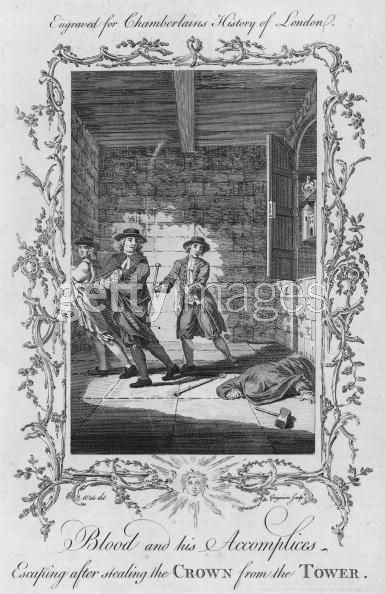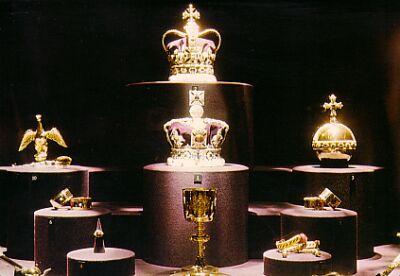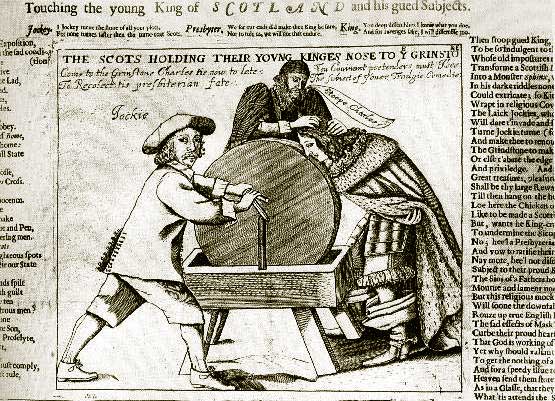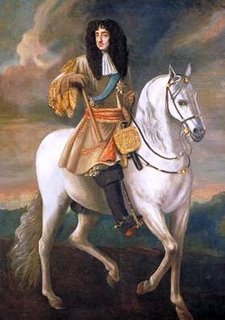Here lies the man who boldly hath run through
More villainles than England ever knew;
And ne’er to any friend he had was true.
Here let him then by all unpitied lie,
And let’s rejoice his time was come to die. ( Colonel Blood Epitaph )

Dressed as a parson, Irish-born soldier and adventurer Colonel Thomas Blood (1618 ??? 1680, second from left) flees the Tower of London with St. Edward's Crown, part of the English Crown Jewels, hidden under his coat, 9th May 1671. Master of the Jewel House Talbot Edwards lies unconscious (right) after being struck with a mallet. Blood was captured in the attempt, but was later mysteriously pardoned, and given land in Ireland by King Charles II. Engraving from Chamberlain's History of London (Photo by Hulton Archive/Getty Images)
…One day in 1671 Blood, disguised as a ‘parson’ went to see the Crown Jewels and became friendly with Edwards, returning at a later date with a woman introduced as his wife. As the visitors were leaving, Mrs. Blood had a violent stomach-ache and was taken to Edward’s apartment to rest.During the tour of the Tower, the “wife” fainted and the keeper took them both to his rooms. During the conversation which followed, Blood managed to extract information about the private life of the keeper, Talbot Edwards.
He found out that Edwards had an unmarried daughter, and he made up a wealthy nephew who would make a suitable husband for her. The Edwards family and ‘Parson Blood’ became close friends and met frequently. Edwards had a pretty daughter and was delighted when ‘Parson Blood’ proposed a meeting between his wealthy nephew and Edward’s daughter. The union was agreed upon and, a few days later, the wedding party arrived at the Tower. Each member of the bridegroom’s party had a sword concealed under his coat. While they were waiting for Edward’s daughter to appear, someone suggested a visit to the Jewel Room. As soon as the group entered, Talbot was gagged and hit on the head with a mallet.

"Having knocked the jewel keeper on the head with a mallet, he squashed the arches of Charles II’s state crown so as to hide it under his cloak whilst his son started to saw the Sceptre in half! Their friend Robert Perot stuck the Orb down his breeches. Just as they were about to escape, the keeper’s son returned unexpectedly and raised the alarm. Blood was arrested, but no-one’s sure quite why, but ‘the merry monarch’, Charles II, pardoned Blood and in fact gave him a pension!"
Surprisingly, Colonel Blood was never punished for the robbery. He insisted on confessing his crime before the king. Charles II, having a similar sense of humour to Blood’s, was amused by his stories and his adventurous spirit. Blood was allowed to return unharmed to his estates in Ireland.
… On an April day in 1671, a clerical gentleman, unctuous and amply bearded, wearing the short gown, white necklace, and ear lapped cap of a Doctor of Divinity, and lending his arm to his demure lady, presented himself at the Tower of London and prayed leave to view its historic relics. Permission was granted;a guide led the way across the drawbridged moat, under the porticullis, past the double ring of mighty walls to the inner court, with its towers and barbed windows framing angry faces.
The visitors were particularly desirous to see the royal regalia, the richly jeweled crown, orb and scepter used in the coronation of Charles II in 1660. These were preserved in the Martin Tower, in a closet opening off a small waiting room. They were under the charge of a seventy-six year old veteran, Talbot Edwards, who lived overhead with his family. Edwards was not loath to show his treasures; indeed his only income was derived from the thank-offerings of the curious. His procedure was to display the regalia through a grilled window. On this occasion the awe of the spectators was such that the lady was seized with “a qualm upon her stomach” Kindly Mr. Edwards bore her to his aprtment and laid her on his own bed, while his wife and daughter administered rousing cordials.
The clergyman was deeply grateful and returned several days later with several pairs of white gloves for Mrs. Edwards.He captivated the family and was in turn captivated by the winsome miss. He remarked that she would be just the mate for his own well-to-do nephew, in quest of a bride. The Edwardses would hardly discourage a match promising property and status; it was arranged that the clergyman should bring his nephew for inspection.
On May 9, at seven in the morning, the clergyman, now a familiar figure to the guards, appeared with the nephew , who was in fact his own stalwart son, and two companions. Each carried a sword stick, pistols, daggers, a wooden mallet, a file and a gag, or wooden block about two inches in diameter, pierced by a small hole and fitted with straps and buckles. Since Miss Edwards was not yet ready for presentation, the cleryman suggested that her father beguile the time by showing his party the regalia. Edwards was mugged; Colonel Blood, faux clergyman, seized the crown of England and pounded it with the mallet so that it would fit under his cassock. Another of the party thrust the orb into his breeches. A third, finding the scepter too long for concealment, began to file it in two.
Unfortunately, Edwards son appeared , summoned no doubt by the news of the promised betrothal; the robbers took fright and made off with the crown and orb, abandoning the half sawn scepter. Young Edwards realeased his bloodied but struggling father and the two gave the alarm, shouting: “Treason! The crown is stolen!” Blood felled a yeomen at the Byward Tower with a pistol shot and the fugitives were out of the tower. Instead of plunging into the dark of the old city, they turned back along the river. Sentries on the battlements perceived them, shouting “Treason!” Riverbank loiterers sprang to the attack in a confused hurly-burly, but after “a robustious struggle” , the plotters were captured and returned to the Tower.
In prison Blood refused to answer any inquiries put to him. He would speak he said, to King Charlles in person, and to him alone. Blood had a long record of offenses against the state. By appealing to the king he attempted to remove them from the purview of ordinary justice , to claim they were political and not merely mercenary. Theft, and even murder, if for political ends, do not derogate; the traitor is honorably beheaded, not basely hung.

1933: A bewigged Allan Jeayes (1885-1963) and Frank Cellier (1884-1948) in a scene from the period drama 'Colonel Blood', directed by W P Lipscomb for Sound City. (Photo by Hulton Archive/Getty Images)
Blood’s demand for a royal audience was shrewd as well as arrogant. He knew te merry monarch’s character, his cynical curiosity, his liking for the unconventional. The Colonel played for high stakes, and won. Apparently he assumed a hearty man-to-man air with his master, hinting of seditious plots that he could not reveal, or at least not without a bargain. What exactly took place in the colloquy was not revealed. Presumably Blood implicated high placed nobles in his raid on the crown and promised revelation about the king’s hidden enemies.
At all events, to the amazement of the court, the King granted a pardon to Blood, and later to his son and associates, for all treasons, murders, felonies etc. Blood’s confiscated lands in Ireland were restored to him, and he was given a pension of five hundred pounds a year. Blood had need for pardon; his offenses were many and black.
Whilst valiant Blood, his rents to have regain’d
Upon the Royal Diadem distrain’d,
He chose the cassock, surcingle and gown,
The fittest mask for those who robb the Crown;
But his lay pity underneath prevailed,
And while he sav’d the Keeper’s life, he failed
With the Priests vestments had he but put on
A Bishop’s cruelty, the Crown was gone. ( Andrew Marvell )
Blood had originally sided with Cromwell, and his family’s land holdings were augmented with an additional grant of land confiscated from royalist owners. But after the Restoration of 1660, most of his holdings were seized by the Court of Claims, and Blood, embittered, joined the underground enemies of the new regime. Blood and other malcontents plotted to kidnap the Duke of Ormonde in a bold ingenious plan, but too many people were involved and inevitably, an informer sold out. The plot was foiled and Blood, by a combination of luck and cunning, escaped. He was declared an outlaw with a bounty on his head.
He wandered about Ireland, disguised as an Anabaptist, a Quaker, or a Catholic priest; he had a liking for the cloth. Forever plotting, he visited Holland and then settled in a village near London, where he practiced medicine under the name Ayloffe. A second attempt on Ormonde, now high steward of England, was also foiled- but this time the duke did not get off until he had been rolled in the mud on Piccadilly, opposite what is today the Ritz.
After his pardon from the king for the attempted rape of the crown jewels, Blood served as an informer. He was involved in various dark transactions, including an effort to blackmail the great Duke of Buckingham. Brazenly, he frequented the court. John Evelyn the diarist met him at dinner and found him an impudent, bold fellow with ” a daring but villanous unmerciful look, a false countenance, but very well spoken and dangerously insinuating. ” He had influence to peddle, and also insurance against denunciation. He died in 1680, to general delight.

" Robert Walker’s portrait of Evelyn captures him in the first flush of his enthusiasm for the classical world. It conveys the restless energies of a man who, during the course of his long life, would write on subjects as diverse as forestry, engraving, numismatics, air pollution and refrigeration, as well as suggesting the depth of his attachment to the moral and intellectual legacy of antiquity. The sitter, who surely took a hand in fashioning his own iconography, adopts the fashionable pose of a melancholic – the “melancholy” humour having been associated since antiquity with genius and creative intelligence. His feelings of morbidity are emphasised by the skull on which he meditates in a way that recalls the soliloquies of that slightly earlier, self-consciously fashionable melancholic, Hamlet. But Evelyn’s strong awareness of the inevitability of death is presented, here, both as a mark of his intellectual maturity and as a tie that binds him to the illustrious thinkers of the distant past."
All this is too bad. Colonel Blood had the makings of a popular hero, the swashbuckling, gallant, ticklish on the point of honor, contriver of fantastic audacities. he might have lodged in Fame’s temple with d’Artagnan and James Bond. But he ruined all this by his latter end as a greedy delator, a turncoat spy.
“Not long after all this, the English author and diarist John Evelyn was invited to dine at the king’s table. When he arrived at the dinner, he was astounded to see Thomas Blood seated near the king. This didn’t make sense to Evelyn, who knew that the Irishman had served as a parliamentarian in the Civil War and had made numerous kidnap attempts on the nobility. Yet, despite these crimes of treason, and the attempted theft and damaging of the Crown Jewels and the murder of the old keeper who looked after them, Blood was apparently still held in favour by the king. And therein lies the mystery that has baffled generations of historians.”









 COMMENTS
COMMENTS